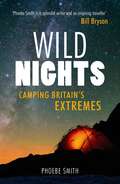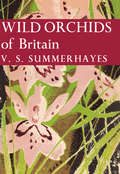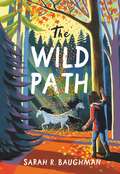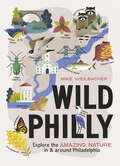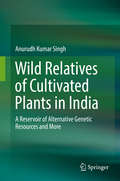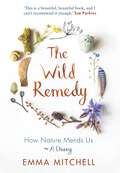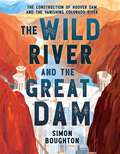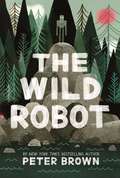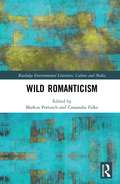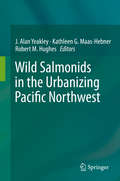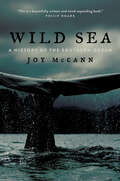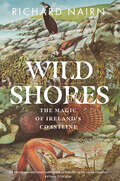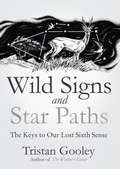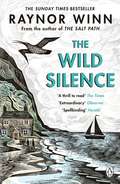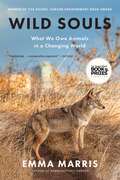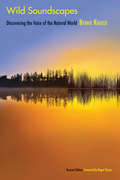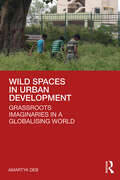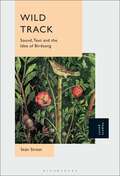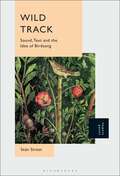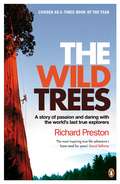- Table View
- List View
Wild Nights: Camping Britain's Extremes
by Phoebe SmithBritain’s most famous wild camper, Phoebe Smith, is back. Battling whiteouts in Wales, facing monster waves in Suffolk and making camp on Britain’s highest mountain, Phoebe takes us on a series of inspirational expeditions into the wilderness as she quests to find the ultimate pitch.
Wild Orchids of Britain (Collins New Naturalist Library #19)
by V. S. SummerhayesA treasure for all lovers of wild plants – Wild Orchids of Britain provides a detailed account of all our orchid species, varieties and hybrids, and has a useful key to identification. This edition is exclusive to newnaturalists.com
The Wild Path
by Sarah R. BaughmanThe Line Tender meets The Secret Horses of Briar Hill in this hopeful, heartfelt story about one girl's search for legendary horses and her quest to piece her family back together.Twelve-year-old Claire Barton doesn't like the "flutter feeling" that fills her chest when she worries about the future, but she knows what she loves: the land that's been in her family for three generations; her best friend Maya; her family's horses, Sunny and Sam; and her older brother Andy. That's why, with Andy recently sent to rehab and her parents planning to sell the horses, Claire's world feels like it might flutter to pieces.When Claire learns about equine therapy, she imagines a less lonely future that keeps her family together, brother and horses included. But, when she finds what seem to be mysterious wild horses in the woods behind her house, she realizes she has a bit more company than she bargained for. With this new secret -- and a little bit of luck -- Claire will discover the beauty of change, the power of family, and the strength within herself.
Wild Philly: Explore the Amazing Nature in and Around Philadelphia
by Mike WeilbacherA vibrant, informative guide to the unexpected nature found in and around Philadelphia and the surrounding area.
Wild Relatives of Cultivated Plants in India: A Reservoir of Alternative Genetic Resources and More
by Anurudh Kumar SinghThis book provides a comprehensive overview of the wild relatives of crops and cultivated species found in India, covering their distribution, phylogenetic relationships with cultivated species, traits that are of economic and breeding value, and the perceived threats. It highlights the opportunities the wild relatives of cultivated species offer in terms of new genes and allelic variability, as well as several other exploitable economic and environmental benefits that can be harnessed with their conservation and cultivation. This helps facilitate their use – both directly and as part of the breeding program for related cultivated species, filling the gaps of genetic variability in the primary gene pool. It also discusses how they can be used in breeding programs using conventional technologies and the biotechnological approaches of recombinant DNA. Transfer of natural genes using recombinant DNA, known as “Cisgenesis,” can accelerate the process of incorporating these natural genes without genetic drag of undesirable features and biosafety concerns, and beyond taxonomic boundaries, in response to the demand for new cultivars to meet the challenges of climate change and ever-growing human population.
The Wild Remedy: How Nature Mends Us - A Diary
by Emma MitchellTHE SUNDAY TIMES BESTSELLER Emma Mitchell's richly illustrated and evocative diary records her nature finds over the course of a year and shows how being in the wild benefits our mental and physical wellbeing. 'This is a beautiful, beautiful book, I can't recommend it enough.' Sue Perkins_________________________‘Profound, inspiring and exquisite.’ Emma Freud_________________________‘Precise, gorgeous and inspiring.’ Amy Liptrot _________________________Emma Mitchell has suffered with depression – or as she calls it, 'the grey slug' – for twenty-five years. In 2003, she moved from the city to the edge of the Cambridgeshire Fens and began to take walks in the countryside around her new home, photographing, collecting and drawing as she went. In Emma's hand-illustrated diary, she takes us with her as she follows the local paths and trails, sharing her nature finds over the course of a year. Reflecting on how these encounters impact her mood, Emma's candid account of her own struggles is a powerful testament to how reconnecting with nature can be as medicinal as any talking therapy or pharmaceutical.Written with Emma's characteristic wit and frankness, and filled with her beautiful drawings, paintings and photography, this is a truly unique book for anyone who has ever felt drawn to nature and wondered about its influence over us.
The Wild River and the Great Dam: The Construction of Hoover Dam and the Vanishing Colorado River
by Simon Boughton★ "In this detailed and informative work, Boughton chronicles the construction of the Hoover Dam via compellingly comprehensive text." —Publishers Weekly, starred review ★ "This well-written narrative is bound to become the authority on this modern American marvel." —Booklist, starred review"A fascinating blend of social and environmental history and engineering." —Kirkus Reviews "Truly breathtaking. This is a powerful story and like the water slowly rising behind that concrete barrier, it becomes more powerful with each page turn." —David Macaulay, two-time recipient of the Caldecott Medal and creator of the bestselling The Way Things Work"An exciting mix of research, storytelling, and an astounding true story—one that&’s still unfolding today." —Steve Sheinkin, three-time National Book Award finalist and Newbery Honor author of Bomb Discover the complicated history behind the construction of Hoover Dam—one of the country&’s most recognizable and far-reaching landmarks—and its lasting political and environmental effects on the Colorado River and the American West. At the time of its completion in 1936, Hoover Dam was the biggest dam in the world and the largest feat of architecture and engineering in the country—a statement of national ambition and technical achievement. It turned the wild Colorado River into a tame and securely managed water source, transforming millions of acres of desert into farmland while also providing water and power to the fast-growing population of the Southwest. The concrete monolith quickly became a symbol of American ingenuity; however, its history is laden with contradiction. It provided work for thousands, but it was a dangerous project that exploited desperate workers during the Depression. It helped secure the settlement and economies of the Southwest, but at the expense of Indigenous peoples and the environment; and it created a dependency on the Colorado River&’s water, which is under threat from overuse and climate change. Weaving together elements of engineering, geography, and political and socioeconomic history, and drawing heavily from unpublished oral histories taken from dam workers and their families, Simon Boughton&’s thoughtful and compelling debut—featuring historical photographs throughout—follows the construction and impact of Hoover Dam, and how its promise of abundance ultimately created a river in crisis today.
The Wild Robot
by Peter BrownWhen robot Roz opens her eyes for the first time, she discovers that she is alone on a remote, wild island. She has no idea how she got there or what her purpose is - but she knows she needs to survive. After battling a fierce storm and escaping a vicious bear attack, she realises that her only hope for survival is to adapt to her surroundings and learn from the island's unwelcoming animal inhabitants. As Roz slowly befriends the animals, the island starts to feel like home - until, one day, her mysterious past comes back to haunt her. From bestselling and award-winning author and illustrator Peter Brown comes a heartwarming and action-packed novel about what happens when nature and technology collide. By turns funny, moving, surprising and dramatic, this is a novel that is as thought-provoking as it is enchanting.
Wild Romanticism (Routledge Environmental Literature, Culture and Media)
by Markus Poetzsch Cassandra FalkeWild Romanticism consolidates contemporary thinking about conceptions of the wild in British and European Romanticism, clarifying the emergence of wilderness as a cultural, symbolic, and ecological idea. This volume brings together the work of twelve scholars, who examine representations of wildness in canonical texts such as Frankenstein, Northanger Abbey, "Kubla Khan," "Expostulation and Reply," and Childe Harold´s Pilgrimage, as well as lesser-known works by Radcliffe, Clare, Hölderlin, P.B. Shelley, and Hogg. Celebrating the wild provided Romantic-period authors with a way of thinking about nature that resists instrumentalization and anthropocentricism, but writing about wilderness also engaged them in debates about the sublime and picturesque as aesthetic categories, about gender and the cultivation of independence as natural, and about the ability of natural forces to resist categorical or literal enclosure. This book will be of great interest to students and scholars of Romanticism, environmental literature, environmental history, and the environmental humanities more broadly.
Wild Romanticism (Routledge Environmental Literature, Culture and Media)
by Markus Poetzsch Cassandra FalkeWild Romanticism consolidates contemporary thinking about conceptions of the wild in British and European Romanticism, clarifying the emergence of wilderness as a cultural, symbolic, and ecological idea. This volume brings together the work of twelve scholars, who examine representations of wildness in canonical texts such as Frankenstein, Northanger Abbey, "Kubla Khan," "Expostulation and Reply," and Childe Harold´s Pilgrimage, as well as lesser-known works by Radcliffe, Clare, Hölderlin, P.B. Shelley, and Hogg. Celebrating the wild provided Romantic-period authors with a way of thinking about nature that resists instrumentalization and anthropocentricism, but writing about wilderness also engaged them in debates about the sublime and picturesque as aesthetic categories, about gender and the cultivation of independence as natural, and about the ability of natural forces to resist categorical or literal enclosure. This book will be of great interest to students and scholars of Romanticism, environmental literature, environmental history, and the environmental humanities more broadly.
Wild Salmonids in the Urbanizing Pacific Northwest
by J. Alan Yeakley Kathleen G. Maas-Hebner Robert M. HughesWild salmon, trout, char, grayling, and whitefish (collectively salmonids) have been a significant local food and cultural resource for Pacific Northwest peoples for millennia. The location, size, and distribution of urban areas along streams, rivers, estuaries, and coasts directly and indirectly alter and degrade wild salmonid populations and their habitats. Although urban and exurban areas typically cover a smaller fraction of the landscape than other land uses combined, they have profound consequences for local ecosystems, aquatic and terrestrial populations, and water quality and quantity.
Wild Sea: A History of the Southern Ocean
by Joy McCann“The Southern Ocean is a wild and elusive place, an ocean like no other. With its waters lying between the Antarctic continent and the southern coastlines of Australia, New Zealand, South America, and South Africa, it is the most remote and inaccessible part of the planetary ocean, the only part that flows around Earth unimpeded by any landmass. It is notorious amongst sailors for its tempestuous winds and hazardous fog and ice. Yet it is a difficult ocean to pin down. Its southern boundary, defined by the icy continent of Antarctica, is constantly moving in a seasonal dance of freeze and thaw. To the north, its waters meet and mingle with those of the Atlantic, Indian, and Pacific Oceans along a fluid boundary that defies the neat lines of a cartographer.” So begins Joy McCann’s Wild Sea, the remarkable story of the world’s remote Southern, or Antarctic, Ocean. Unlike the Pacific, Atlantic, Indian, and Arctic Oceans with their long maritime histories, little is known about the Southern Ocean. This book takes readers beyond the familiar heroic narratives of polar exploration to explore the nature of this stormy circumpolar ocean and its place in Western and Indigenous histories. Drawing from a vast archive of charts and maps, sea captains’ journals, whalers’ log books, missionaries’ correspondence, voyagers’ letters, scientific reports, stories, myths, and her own experiences, McCann embarks on a voyage of discovery across its surfaces and into its depths, revealing its distinctive physical and biological processes as well as the people, species, events, and ideas that have shaped our perceptions of it. The result is both a global story of changing scientific knowledge about oceans and their vulnerability to human actions and a local one, showing how the Southern Ocean has defined and sustained southern environments and people over time. Beautifully and powerfully written, Wild Sea will raise a broader awareness and appreciation of the natural and cultural history of this little-known ocean and its emerging importance as a barometer of planetary climate change.
Wild Sea: A History of the Southern Ocean
by Joy McCann“The Southern Ocean is a wild and elusive place, an ocean like no other. With its waters lying between the Antarctic continent and the southern coastlines of Australia, New Zealand, South America, and South Africa, it is the most remote and inaccessible part of the planetary ocean, the only part that flows around Earth unimpeded by any landmass. It is notorious amongst sailors for its tempestuous winds and hazardous fog and ice. Yet it is a difficult ocean to pin down. Its southern boundary, defined by the icy continent of Antarctica, is constantly moving in a seasonal dance of freeze and thaw. To the north, its waters meet and mingle with those of the Atlantic, Indian, and Pacific Oceans along a fluid boundary that defies the neat lines of a cartographer.” So begins Joy McCann’s Wild Sea, the remarkable story of the world’s remote Southern, or Antarctic, Ocean. Unlike the Pacific, Atlantic, Indian, and Arctic Oceans with their long maritime histories, little is known about the Southern Ocean. This book takes readers beyond the familiar heroic narratives of polar exploration to explore the nature of this stormy circumpolar ocean and its place in Western and Indigenous histories. Drawing from a vast archive of charts and maps, sea captains’ journals, whalers’ log books, missionaries’ correspondence, voyagers’ letters, scientific reports, stories, myths, and her own experiences, McCann embarks on a voyage of discovery across its surfaces and into its depths, revealing its distinctive physical and biological processes as well as the people, species, events, and ideas that have shaped our perceptions of it. The result is both a global story of changing scientific knowledge about oceans and their vulnerability to human actions and a local one, showing how the Southern Ocean has defined and sustained southern environments and people over time. Beautifully and powerfully written, Wild Sea will raise a broader awareness and appreciation of the natural and cultural history of this little-known ocean and its emerging importance as a barometer of planetary climate change.
Wild Sea: A History of the Southern Ocean
by Joy McCann“The Southern Ocean is a wild and elusive place, an ocean like no other. With its waters lying between the Antarctic continent and the southern coastlines of Australia, New Zealand, South America, and South Africa, it is the most remote and inaccessible part of the planetary ocean, the only part that flows around Earth unimpeded by any landmass. It is notorious amongst sailors for its tempestuous winds and hazardous fog and ice. Yet it is a difficult ocean to pin down. Its southern boundary, defined by the icy continent of Antarctica, is constantly moving in a seasonal dance of freeze and thaw. To the north, its waters meet and mingle with those of the Atlantic, Indian, and Pacific Oceans along a fluid boundary that defies the neat lines of a cartographer.” So begins Joy McCann’s Wild Sea, the remarkable story of the world’s remote Southern, or Antarctic, Ocean. Unlike the Pacific, Atlantic, Indian, and Arctic Oceans with their long maritime histories, little is known about the Southern Ocean. This book takes readers beyond the familiar heroic narratives of polar exploration to explore the nature of this stormy circumpolar ocean and its place in Western and Indigenous histories. Drawing from a vast archive of charts and maps, sea captains’ journals, whalers’ log books, missionaries’ correspondence, voyagers’ letters, scientific reports, stories, myths, and her own experiences, McCann embarks on a voyage of discovery across its surfaces and into its depths, revealing its distinctive physical and biological processes as well as the people, species, events, and ideas that have shaped our perceptions of it. The result is both a global story of changing scientific knowledge about oceans and their vulnerability to human actions and a local one, showing how the Southern Ocean has defined and sustained southern environments and people over time. Beautifully and powerfully written, Wild Sea will raise a broader awareness and appreciation of the natural and cultural history of this little-known ocean and its emerging importance as a barometer of planetary climate change.
Wild Sea: A History of the Southern Ocean
by Joy McCann“The Southern Ocean is a wild and elusive place, an ocean like no other. With its waters lying between the Antarctic continent and the southern coastlines of Australia, New Zealand, South America, and South Africa, it is the most remote and inaccessible part of the planetary ocean, the only part that flows around Earth unimpeded by any landmass. It is notorious amongst sailors for its tempestuous winds and hazardous fog and ice. Yet it is a difficult ocean to pin down. Its southern boundary, defined by the icy continent of Antarctica, is constantly moving in a seasonal dance of freeze and thaw. To the north, its waters meet and mingle with those of the Atlantic, Indian, and Pacific Oceans along a fluid boundary that defies the neat lines of a cartographer.” So begins Joy McCann’s Wild Sea, the remarkable story of the world’s remote Southern, or Antarctic, Ocean. Unlike the Pacific, Atlantic, Indian, and Arctic Oceans with their long maritime histories, little is known about the Southern Ocean. This book takes readers beyond the familiar heroic narratives of polar exploration to explore the nature of this stormy circumpolar ocean and its place in Western and Indigenous histories. Drawing from a vast archive of charts and maps, sea captains’ journals, whalers’ log books, missionaries’ correspondence, voyagers’ letters, scientific reports, stories, myths, and her own experiences, McCann embarks on a voyage of discovery across its surfaces and into its depths, revealing its distinctive physical and biological processes as well as the people, species, events, and ideas that have shaped our perceptions of it. The result is both a global story of changing scientific knowledge about oceans and their vulnerability to human actions and a local one, showing how the Southern Ocean has defined and sustained southern environments and people over time. Beautifully and powerfully written, Wild Sea will raise a broader awareness and appreciation of the natural and cultural history of this little-known ocean and its emerging importance as a barometer of planetary climate change.
Wild Shores: The Magic of Ireland’s Coastline
by Richard NairnFollowing the Irish coast in a clockwise direction, acclaimed ecologist Richard Nairn travels by boat, on foot and sometimes by air to visit the best remaining wild places, including islands, cliffs, beaches and dunes.The result is a unique mix of nature, history, science and a reflection on the author’s personal experiences of exploring Ireland’s coast. By viewing the Irish coastline from the sea, Richard gains a unique perspective on the island. And along the way, he recalls a lifetime spent studying nature.‘An affectionate and timely celebration of Ireland’s richly varied coastline’ Bryan Dobson‘A great read – whatever part of the coast you visit’ Éanna Ní Lamhna‘A brilliant and timely odyssey around our precious, precarious shores’ Professor John Brannigan, University College Dublin‘An exhilarating journey right around our coastline’ Paddy Woodworth, Journalist and author‘An intimate, inspiring and lovely read about Ireland's shorelines: its places and spaces’ Professor Robert Devoy, Lead Editor of The Coastal Atlas of Ireland
Wild Signs and Star Paths: 'A beautifully written almanac of tricks and tips that we've lost along the way' Observer
by Tristan Gooley'A paean to the beauty and majesty of nature, especially the nature we overlook in our back gardens and local parks... And like all the best books, it makes the world around you a lot more interesting' - Spectator'Beautifully written... I promise you will feel more in tune with the world around after reading only one chapter of Wild Signs and Star Paths, let alone the book in its entirety' - Royal Institute of Navigation'A beautifully written almanac of tricks and tips that we've lost along the way' - ObserverTristan Gooley, author of the internationally bestselling How To Read Water and The Walker's Guide to Outdoor Clues & Signs, shows how it is possible to achieve a level of outdoors awareness that will enable you to sense direction from stars and plants, forecast weather from woodland sounds and predict the next action of an animal from its body language - instantly.Although once common, this now rare awareness would be labelled by many as a 'sixth sense'. We have become so distanced from this way of experiencing our environment that it may initially seem hard to believe that it is possible, but Tristan Gooley uses a collection of 'keys' to show how everyone can develop this ability and enjoy the outdoors in an exciting way - one that is both new and ancient.
The Wild Silence: A Memoir
by Raynor WinnThe incredible follow-up to one of the most talked about books of the decade - the phenomenon, Waterstones Book of the Month and The Sunday Times bestselling The Salt Path._______'Raynor Winn has written a brilliant, powerful and touching account of her life before and after The Salt Path, which, like her astonishing debut, will connect with anyone who has triumphed over adversity' Stephen Moss, author and naturalist'Heartening and comforting . . . The nature writing is beautiful and it is a thrill to read. You feel the world is a better place because Raynor and Moth are in it' Times'A beautiful, luminous and magical piece of writing' Rachel Joyce, author of The Unlikely Pilgrimage of Harold Fry_______Nature holds the answers for Raynor and her husband Moth.After walking 630 miles homeless along The Salt Path, the windswept and wild English coastline now feels like their home.And despite Moth's terminal diagnosis, against all medical odds, he seems revitalized in nature - outside, they discover that anything is possible.Now, life beyond The Salt Path awaits. As they return to four walls, the sense of home is illusive and returning to normality is proving difficult - until an incredible gesture by someone who reads their story changes everything:A chance to breathe life back into a beautiful but neglected farmhouse nestled deep in the Cornish hills; rewilding the land and returning nature to its hedgerows becomes their new path.Along the way, Raynor and Moth learn more about the land that envelopes them, find friends both new and old, and, of course, embark on another windswept adventure when the opportunity arises.The Wild Silence is a story of hope triumphing over despair, of lifelong love prevailing over everything.It is a luminous account of the human spirit's instinctive connection to nature, and how vital it is for us all._______Praise for The Salt Path'An astonishing narrative of two people dragging themselves from the depths of despair along some of the most dramatic landscapes in the country, looking for a solution to their problems and ultimately finding themselves' Independent'This is what you need right now to muster hope and resilience . . . a beautiful story and a reminder that humans can endure adversity' Stylist'The landscape is magical: shapeshifting seas and smugglers' coves; myriads of sea birds and mauve skies. Raynor writes exquisitely. . . it's a tale of triumph; of hope over despair, of love over everything' Sunday Times'The Salt Path is a life-affirming tale of enduring love that smells of the sea and tastes of a rich life. With beautiful, immersive writing, it is a story heart-achingly and beautifully told' Jackie Morris, illustrator of The Lost Words by Robert Macfarlane
Wild Souls: Freedom and Flourishing in the Non-Human World
by Emma MarrisFrom an acclaimed environmental writer, a groundbreaking and provocative new vision for our relationships with--and responsibilities toward--the planet's wild animals.Protecting wild animals and preserving the environment are two ideals so seemingly compatible as to be almost inseparable. But in fact, between animal welfare and conservation science there exists a space of underexamined and unresolved tension: wildness itself. When is it right to capture or feed wild animals for the good of their species? How do we balance the rights of introduced species with those already established within an ecosystem? Can hunting be ecological? Are any animals truly wild on a planet that humans have so thoroughly changed? No clear guidelines yet exist to help us resolve such questions. Transporting readers into the field with scientists tackling these profound challenges, Emma Marris tells the affecting and inspiring stories of animals around the globe--from Peruvian monkeys to Australian bilbies, rare Hawai'ian birds to majestic Oregon wolves. And she offers a companionable tour of the philosophical ideas that may steer our search for sustainability and justice in the non-human world. Revealing just how intertwined animal life and human life really are, Wild Souls will change the way we think about nature-and our place within it.
Wild Soundscapes: Discovering the Voice of the Natural World, Revised Edition (The\future Ser.)
by Bernie KrauseThrough his organization Wild Sanctuary, Bernie Krause has traveled the globe to hear and record the sounds of diverse natural habitats. Wild Soundscapes, first published in 2002, inspires readers to follow in Krause’s footsteps. The book enchantingly shows how to find creature symphonies (or, as Krause calls them, “biophonies”); use simple microphones to hear more; and record, mix, and create new expressions with the gathered sounds. After reading this book, readers will feel compelled to investigate a wide range of habitats and animal sounds, from the conversations of birds and howling sand dunes to singing anthills. This rewritten and updated edition explains the newest technological advances and research, encouraging readers to understand the earth’s soundscapes in ways previously unimaginable. With links to the sounds that are discussed in the text, this accessible and engaging guide to natural soundscapes will captivate amateur naturalists, field recordists, musicians, and anyone else who wants to fully appreciate the sounds of our natural world.
Wild Spaces in Urban Development: Grassroots Imaginaries in a Globalising World
by Amartya DebThis fascinating book examines how microsites of spontaneous nature can reframe our understanding of the relationship between urban development and green space. Metropolitan cities are facing stark inequalities of green space distribution, hindering goals of sustainable development. But outside of human control, spontaneous nature grows in spaces that are neglected or are unaccounted for. Drawing on existing literature and primary research in a range of towns and cities, including Quito in Ecuador, Bengaluru and Kolkata in India, and Whitby in the United Kingdom, the book delves into the morphology, meanings, and values of those small-scale assemblages of wild growth which are typically overlooked. Discussing instead how such settings can be integrated into everyday urban life, the book offers a fresh perspective on issues around green infrastructure, heritage conservation, and environmental education, enabling cities worldwide to become more nature-positive. A unique examination of an under-researched topic, this book will appeal to students, researchers, and professionals across landscape architecture, urban planning, urban ecology, and all related fields.
Wild Spaces in Urban Development: Grassroots Imaginaries in a Globalising World
by Amartya DebThis fascinating book examines how microsites of spontaneous nature can reframe our understanding of the relationship between urban development and green space. Metropolitan cities are facing stark inequalities of green space distribution, hindering goals of sustainable development. But outside of human control, spontaneous nature grows in spaces that are neglected or are unaccounted for. Drawing on existing literature and primary research in a range of towns and cities, including Quito in Ecuador, Bengaluru and Kolkata in India, and Whitby in the United Kingdom, the book delves into the morphology, meanings, and values of those small-scale assemblages of wild growth which are typically overlooked. Discussing instead how such settings can be integrated into everyday urban life, the book offers a fresh perspective on issues around green infrastructure, heritage conservation, and environmental education, enabling cities worldwide to become more nature-positive. A unique examination of an under-researched topic, this book will appeal to students, researchers, and professionals across landscape architecture, urban planning, urban ecology, and all related fields.
Wild Track: Sound, Text and the Idea of Birdsong
by Seán StreetWild Track is an exploration of birdsong and the ways in which that sound was conveyed, described and responded to through text, prior to the advent of recording and broadcast technologies in the late 19th and early 20th centuries. Street links sound aesthetics, radio, natural history, and literature to explore how the brain and imagination translate sonic codes as well as the nature of the silent sound we "hear" when we read a text. This creates an awareness of sound through the tuned attention of the senses, learning from sound texts of the natural world that sought – and seek – to convey the intensity of the sonic moment and fleeting experience. To absorb these lessons is to enable a more highly interactive relationship with sound and listening, and to interpret the subtleties of audio as a means of expression and translation of the living world.
Wild Track: Sound, Text and the Idea of Birdsong
by Seán StreetWild Track is an exploration of birdsong and the ways in which that sound was conveyed, described and responded to through text, prior to the advent of recording and broadcast technologies in the late 19th and early 20th centuries. Street links sound aesthetics, radio, natural history, and literature to explore how the brain and imagination translate sonic codes as well as the nature of the silent sound we "hear" when we read a text. This creates an awareness of sound through the tuned attention of the senses, learning from sound texts of the natural world that sought – and seek – to convey the intensity of the sonic moment and fleeting experience. To absorb these lessons is to enable a more highly interactive relationship with sound and listening, and to interpret the subtleties of audio as a means of expression and translation of the living world.
The Wild Trees: A Story of Passion and Daring with the World's Last True Explorers
by Richard PrestonWhen Steve Sillett was 19 years old, he free-climbed – with no safety equipment and no training – one of the tallest trees on earth, in the redwood forests of Prairie Creek, California. 30 storeys above the ground he glimpsed an undiscovered ecosystem, and his passion for that astonishing world would transform the rest of his life. Over the next twenty years, Sillett and a close group of friends charted this system, discovering mosses and lichen never seen before, and travelling among branches so densely interwoven they form incredible sky-high walkways. There are only twenty people on earth who have climbed the world’s tallest trees and who know their location. In writing The Wild Trees, Richard Preston not only managed to gain access to this group, but began to climb these hidden giants himself, putting his life in danger in order to understand the powerful connection between the massive trees and the world’s last great explorers.
